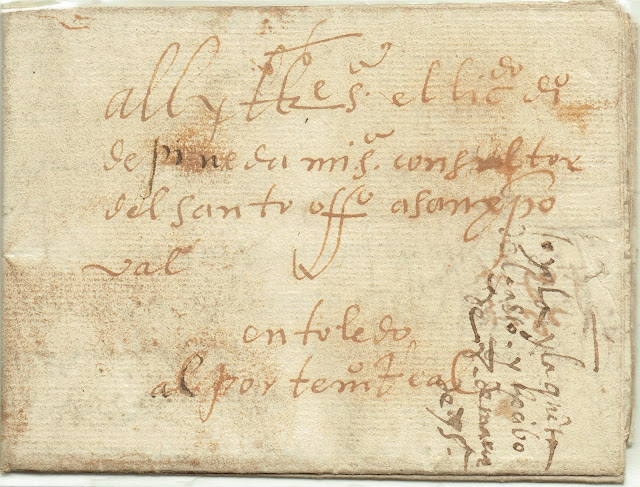While in Verona in November 2019, at the ECTP 2019 exhibition, in which I won the Champion of Champion class (hey if I don't blow my own trumpet, who will), I saw an exhibit on Columbus. I discussed with a friend to and we decided to see how the exhibitor approached the issue of Queen Isabella of Spain. I wanted to improve my page about Jews not being wanted.
We thought that there may be covers of some kind, sent by Queen Isabella, and then we saw it, the WOW item. It was a cover sent to Friar Diego Pineda of Toledo in 1582. Friar Diego Pineda was an official consultant to the Santo Oficio a San Cristóbal or the Holy Office of the Inquisition. We never even considered this direction.
We will not go into the history of the Inquisition as many of us already know it; the history is not new to us. Just to make it short, the Spanish Inquisition was established in 1478 by Catholic Monarchs Ferdinand II of Aragon and Isabella I of Castile. It was intended to maintain Catholic orthodoxy in their kingdom and to replace the Medieval Inquisition, which was under Papal control.
Basically they said "its our way or the highway" meaning either convert, be killed or leave.
The full name of the Inquisition was Santo Oficio de la Romana y Universal Inquisicion or “Holy Work of the Roman and Universal Inquisition". Santo Oficio means “Holy Job or Work”. Since the name was actually Holy Work of the Roman and Universal Inquisition, it was shortened to el Santo Oficio which was a far more used name for the institution than Inquisition, which was the preferred term of Anglophile countries, most likely because for Protestants, Holy Work sounds too good for the evil abhorrent Catholic tribunal.
The tribunal in Toledo was established in 1485 and the Inquisitor General there presided over the court in the Church of San Cristobal. As yet I have not been able to find information about the consultant just that his full name was Friar Diego Pineda.
The story of the inquisition fits my story perfectly. Now I really needed an item of my own. I approached the exhibitor who put me in touch with a site. I did a search there and found the cover he originally purchased and amazingly found a second item which I immediately purchased.
The cover eventually arrived and it is quite similar. It was also sent from Madrid to Toledo, again to Friar Pineda. Sent 8th March, 1575, and postage paid was ½Real.
Let us get a tad boring for a moment while I explain something. Up until 1580, the mail service within Spain was for the service of kings and nobility. Sending a letter or official documents at this time was very expensive because you had to pay the service of the postman, the benefit of the postmaster, the accommodation and the maintenance of the mail during the route, the food for the horse and others. If the king sent a letter from Madrid to Toledo, the postage rate was 100 Reals. Some private individuals also gave the postman their private correspondence and only paid a token amount of ½ Real, which is what my letter was charged. By doing this, the courier could not ask Friar Diego to pay up.
Now according to exhibiting rules, the name of the recipient does not enable us to use an item, unless the recipient had special postal privileges, in this case the full postage was paid. Does this make it illegitimate? According to the new SREV for thematic, this is considered borderline. It is legitimate because it is the best item to use to display the thematic point, the inquisition.
I now have a WOW item in my exhibit.
Note: This article was previously published in the Israeli Thematic Bulletin and the British THematic bulletin








A WOW Item with a WOW story (:
ReplyDeleteVery nice story and WOW item indeed!. Regarding the name of the recipient and exhibit rules, in one of my exhibits (postal history, class 2c social/historical studies), related to the 3 companies tried for war crimes at Nuremberg, I have some letters addressed to Hermann Schmidt, CEO of IG Farben, the chemical conglomerate that owned the company that produced Zyklon-B, among other crimes. That letter has the War Crimes censorship applied in Dachau and I have others with the same censor marks from other camps. So, in those covers, the recipient is the most important aspect for me, because he was the CEO of one of the companies, condemned as war criminal, that explain the censorship, and that together with the location in the camps, the censorship, etc, tells the full story. Another example where recipient or sender matters are the ones with "Sara" and "Israel" added to the names due to Nuremberg laws. In those cases recipient/sender are the most important aspect. So, maybe recipient doesn't matter for most covers, but for some are the key, no doubt.
ReplyDeleteAbsolutely Incredible !!!!!!!!!!! this is history our history
ReplyDeleteits a museum piece - well done
Les Glassman
Can you send me the seller website by email? I search one about inquisition for my chocolate exhibit. regards
ReplyDelete